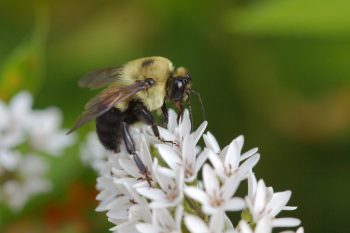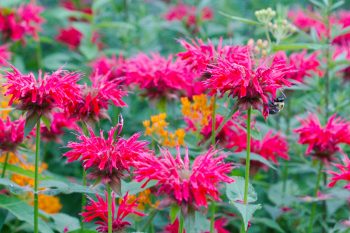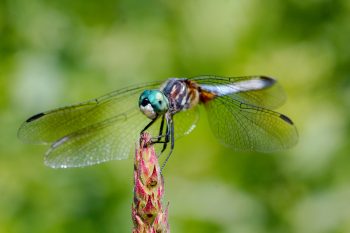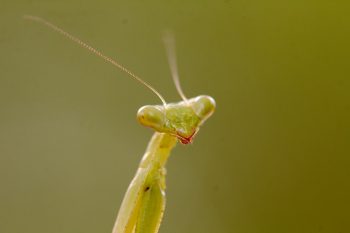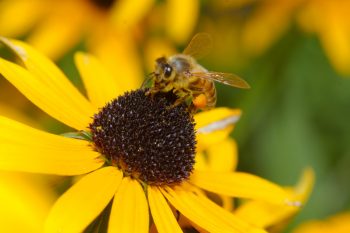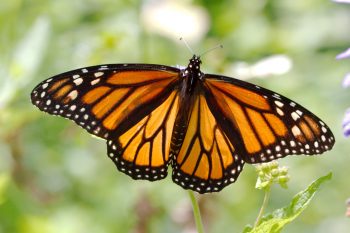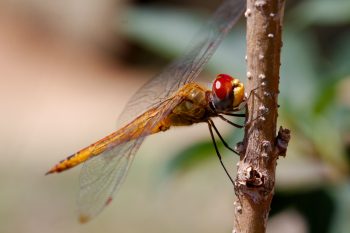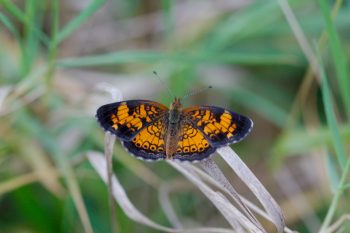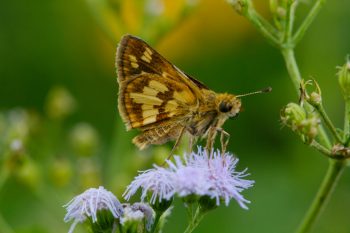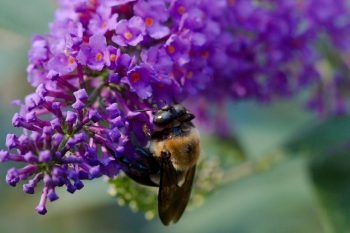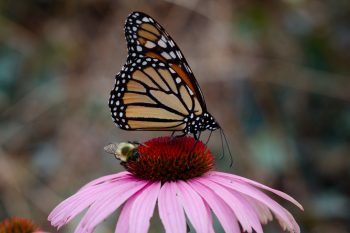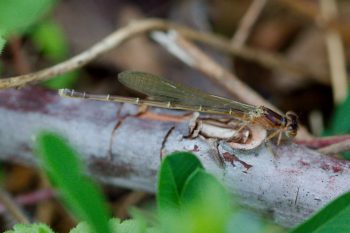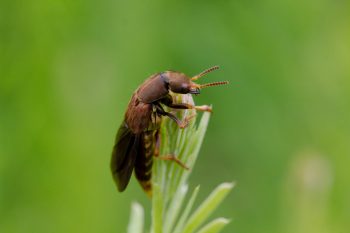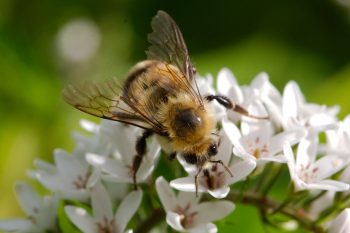The gooseneck loosestrife (Lysimachia clethroides) is in bloom and that generally means I have an opportunity to photograph common eastern bumblebees (Bombus impatiens) like this one. I don’t recommend planting loosestrife unless you really enjoy digging up plants where they appear throughout your garden. It can easily get ahead of you. We sometimes joke about planting two aggressive plants in a container and waiting to see which comes out on top. This has got to be a contender. It does have nice flowers, though, and its attractiveness to bees speaks well of it. Nevertheless, if I could get rid of all we had, I wouldn’t think twice about it.
Tagged With: Insect
Eastern Bumblebee (Bombus impatiens)
Monarda, Asclepias, and a Bombus
Along our back fence, the garden has really gotten out of control. With the work we’ve been doing on our mom’s houses, we haven’t really had time to give it half the attention it needs and deserves. Consequently, it’s got goldenrod, poke weed, and thistles growing in abundance. Three of our planted perennials are doing quite well, however, including the bee balm (Monarda didyma, also known as Oswego tea or bergamot) and the butterfly weed (Asclepias tuberosa) shown here. The other, not yet in bloom, is obedient plant (Physostegia virginiana). All three are native to the area and extremely tough. The bees love them and I followed this common eastern bumble bee (Bombus impatiens) for a while as he moved from flower to flower.
Dragonfly
Dorothy thought she had to work from 4:00 to 9:00 PM today but she got a text just after 11:00 saying she was on from 11:00 to 4:00. Fortunately, we were just driving through campus as she got that, so we were there within minutes. Cathy and I enjoyed a walk around Coy Pond and I took a bunch of pictures, including of water lilies, a great blue heron, and this dragonfly. Later we went to the garden at Long Hall and I took more pictures. That was a nice garden with an interesting collection of trees, shrubs, and perennials. Recommended. We had dinner at La Victoria, a trendy but decent taco place just off of Cabot Street in Beverly.
Praying Mantis
After work I met my mom at her house and we emptied the garage. I have a few pictures of it, showing how it’s leaning, particularly at the back. We loaded trash into her van to take to the county transfer station and I took a few things to give away or otherwise deal with. When I got home and was unloading my van I noticed this praying mantis on the roof of Margaret’s car. I believe but am not sure that it is a Chinese mantis (Tenodera sinensis). I think it is not fully grown, as it was only about two inches long. Like true bugs, grasshoppers, cockroaches, and crickets (to name a few), the mantises undergo what is known as incomplete metamorphosis. That is, instead of larval and pupal stages, the emerge from their eggs as nymphs and grow through a series of instars, where they shed their exoskeletons as they grow.
Honey Bee on Rudbekia
As I’ve mentioned before, the garden is somewhat overrun with Rudbekia (a.k.a. black-eyed Susan) flowers. The bees don’t mind. There are, actually, other things in bloom, but none nearly as obvious. The mountain mint (Pycnanthemum muticum), for instance, is very popular with the bees of all sorts. But their flowers are much less showy. This afternoon I took a bunch of pictures of various bees on the black-eye Susan flowers. This one is a western honey bee, Apis mellifera. Contrary to popular belief, they are in no real danger of all dying out. You can, to a large degree, thank capitalism for that, although I think the danger was considerably exagerated, in any case.
Monarch (Danaus plexippus)
I got a few nice arthropod photos today, one spider (a Basilica Orbweaver (Mecynogea lemniscata) and a few bees. My post for today came down to a choice between this monarch and a photo of a Philanthus gibbosus, one of the thirty-some species of beewolves in our area. It’s a pretty little bee with pitted chitin and a distinctive pattern of yellow and black. I photographed it on a black-eyed Susan, which went well with its coloration. Nevertheless, I’ve decided to go with this rather nice photo of a monarch butterfly (Danaus plexippus). Oddly, most people who dislike insects don’t really mind butterflies. It’s true that they are pretty harmless to humans but then, so are a lot of other, more easily despised insects. Maybe it’s because they are so colorful and pretty, but frankly, I think wasps are pretty, so there.
Wandering Glider (Pantala flavescens)
In a rare turn for late August, it was very pleasant outside today. The high probably wasn’t over about 82°F and it wasn’t humid at all. In the shade it was quite comfortable. To capitalize on such a nice day, Cathy and I met and took a walk around our company campus. Almost immediately when I went outside, I spotted this dragonfly, which I believe to be a wandering glider (Pantala flavescens), one of the skimmers. That ID may be wrong, but nevertheless, it’s a beautiful thing, with its dark yellow markings and striking red eyes.
Pearl Crescent (Phyciodes tharos)
I stopped at the commuter parking lot on Georgia Avenue where it crosses the Intercounty Connector today and took some pictures of insects on wildflowers growing on the hillside above the parking lot. I had originally stopped because there were beautiful clouds to the northwest but by the time I got there the sky was pretty much a uniform grey. There were goldenrod soldier beetles (Chauliognathus pensylvanicus) all over the goldenrod (which makes a lot of sense) and there were quite a few types of bees. I followed this little butterfly around a while until I was able to get close enough for a few decent photographs. The one taken after this is considerably closer but not as sharp, unfortunately. The dwindling light from the heavy overcast was makign it hard. But I enjoyed being out in the wind and with insects all around.
Peck’s Skipper (Polites peckius)
It was dark and raining this morning and into the early afternoon but by 5:00 PM or so the sun was out and it was a beautiful day. I wouldn’t actually have minded the clouds staying around because our air conditioner has called it quits and a little less direct sun would have been welcome. Still, it was nice to get out and look for insects to photograph. This little fellow, a Peck’s skipper (Polites peckius), was on some blue mistflower (Conoclinium coelestinum) in the front garden. I also got some pictures of an eastern tailed-blue (Cupido comyntas) but they weren’t very sharp. Quite shy, those little blues.
Small Cricket
As you walk through a lawn, chances are there are insects jumping away from you much of the time. We often walk through life not noticing things like that. Many of the insects are too small to be of any note. Slightly larger insects, like this cricket, might catch our eye but still not attract much attention. I went out today specifically looking at the little creatures all around and was able to get fairly close to this one before it hopped away. I haven’t had a chance to look it up to get any sort of identification beyond “cricket” but that’s probably good enough for now.
Painted Lady (Vanessa cardui)
I took pictures in the yard this evening. I started with pictures of this butterfly, a painted lady (Vanessa cardui) on the buddleia just into our back yard. It was moving about, skipping from one flower cluster to another but I was able to get a few nice shots from the side (head-on photos of butterflies aren’t very satisfying). I took some pictures of an eastern bumble bee (Bombus impatiens), also on the buddleia. I took pictures of two different purslanes growing in a hanging basket by the back patio.
Monarch (Danaus plexippus)
I had a short break in the usual busyness at work today so was able to get out to take a few pictures. I got a few of a great blue heron (Ardea herodias) and a belted kingfisher (Megaceryle alcyon). I was able to get photos of both of them in flight but they were both pretty far away and they pictures aren’t all that great.
Before I came back inside I walked past some buddleia growing in a flower bed in the front of my building. There were a few monarch butterflies ((Danaus plexippus) flitting around on them. Although the garden was in the shade of the building, there was enough light to get some pretty reasonable photos.
Eastern Carpenter Bee (Xylocopa virginica)
Cathy called me around the south end of the house late this afternoon to take pictures of this male carpenter bee (Xylocopa virginica) on the buddleia growing there. Carpenter bees are nice to photograph because they don’t mind you getting fairly close to them. Also, the males like this one, identified by the white or pale yellow patch on their face, don’t sting and in fact are unable to do so. I don’t find many bees to be particularly aggressive, though, and I know some people are quite afraid of them. For me, as long as I move slowly and carefully, I’ve never had a problem. I’m not particularly allergic, either, which is important.
Monarch and Bumblebee
I know I posted a photo of a monarch butterfly (Danaus plexippus) recently but I sort of like this photo of a monarch sharing a coneflower (Echinacea purpurea) with an eastern bumblebee (Bombus impatiens), so here you are. This was taken in the same garden as the former and like that one it was in the afternoon when the shade of the building was on it, so it isn’t as well lit as I would like.
I walked around the small pond next to my building and saw lots of raccoon footprints in the fresh mud. I took some pictures of those and also of some skippers, a cabbage white (Pieris rapae) and a pearl crescent (Phyciodes tharos).
Eastern Comma (Polygonia comma)
I was a bit surprised this afternoon to see this butterfly and was happy to be able to get close enough for a pretty good photograph. It turns out that the commas overwinter as adults and they can be seen on warmer days, such as today. The name comes from a curved, comma shaped mark on the underside of their hind wings. Another species in the genus has a question mark (and therefore is called the question mark instead of a comma). It’s a pretty little thing and it really brightened up my day to come across it.
Butterflies
One of the things in my in-laws house that we didn’t get rid of was this butterfly collection. It’s a box about 15 by 20 inches that opens up like a book to twice that size. Each side has butterflies mounted between cotton backing and a glass plate. They are quite lovely and varied. Not shown here is a very large butterfly that is bright blue on its underside (which is the visible side in the collection). The other side, the upper sides of the wings are brown. In this way, it blends in with the the earth from above and with the sky from below.
Small Damselfly
I walked across Rt 28 today, wanting to be outdoors for a little while. On the slope leading down to a fairly large drainage pond there were little clumps of yellow flowers, most likely American wintercress (Barbarea orthoceras). I sat next to one such clump and took a handful of pictures. I thought about trying to get a photo of the swallows that were patrolling the pond and presumably helping keep the bug population under control. I didn’t really have the right equipment for that and it’s pretty tough, in any case, as they are really moving fast and are not very big. I settled for photographing this little damselfly instead.
Rove Beetle
I wen out again today to see what I could see. The sky was overcast so the sun wasn’t so hot. The dragonflies were also not about in such great numbers. I did get a few pictures,though, including some of this beetle that I think is a rove beetle, Family Staphylinidae, the first or second largest animal family, with somewhere around 56,000 species in 3500 genera. Only the ichneumon wasps, family Ichneumonidae is larger, with an estimated 60,000 species. Anyway, there are some 4,400 species of rove beetle in our area. You’d think you’d see them a lot more often.
Eastern Bumble Bee
I went out looking for pictures as usual this afternoon, when I got home from work. There is Campanula in bloom in the yard, and I took some pictures of those flowers. They don’t tend to come out the same color in photographs as they are in real life. Not entirely sure why. Then I moved over to the gooseneck loosestrife (Lysimachia clethroides), which is a real attraction to the bees. It’s quite invasive and I really would recommend against planting it in the strongest language, but if you already have it, you might as well enjoy the bees. There were a few honey bees but mostly it was the common eastern bumble bees (Bombus impatiens) that were moving quickly from flower to flower.

